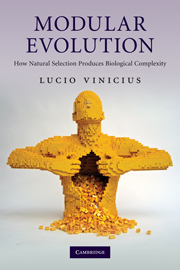Book contents
- Frontmatter
- Contents
- Preface
- 1 From natural selection to the history of nature
- 2 From the units of inheritance to the origin of species
- 3 Multicellularity and the developmental code
- 4 Life cycle evolution: life and death of the soma
- 5 Sex and its consequences: the transition that never happened
- 6 Animal societies: the case of incomplete evolutionary transitions
- 7 The new ‘Chain of Being’: hierarchical evolution and biological complexity
- References
- Index
2 - From the units of inheritance to the origin of species
Published online by Cambridge University Press: 05 June 2012
- Frontmatter
- Contents
- Preface
- 1 From natural selection to the history of nature
- 2 From the units of inheritance to the origin of species
- 3 Multicellularity and the developmental code
- 4 Life cycle evolution: life and death of the soma
- 5 Sex and its consequences: the transition that never happened
- 6 Animal societies: the case of incomplete evolutionary transitions
- 7 The new ‘Chain of Being’: hierarchical evolution and biological complexity
- References
- Index
Summary
By the time of Darwin and Wallace's death the belief in evolution and descent with modification of species was well established, but enthusiasm for natural selection as the mechanism or law of evolution remained meagre until the 1930s (Bennettt, 1999). The most likely reason for scepticism was that the genetic theories considered by Darwin and other naturalists, including pangenesis (the origin of the hereditary material from the fusion of body organ samples or ‘gemules’; Darwin, 1868), Nägeli's blending theory (the averaging of parents' traits in sexually produced offspring; see Ospovat, 1980 and Berry, 2000) and inheritance of acquired characters (see Mayr and Provine, 1980) failed to account adequately for inheritable variation in natural populations and were at odds with experimental work done by geneticists (Osborn, 1926). Crampton (1928) believed that ‘little if any understanding of the origin of organic types can be gained through the study of genera, species or even varieties, after they have arisen … the geneticists and they alone are working on the fundamental dynamics of organic differentiation’. For this reason, natural selection was still struggling to gain respect among biologists 70 years after its birth: as summed up by Watson (1929), ‘the only two “theories of evolution” which have gained any general currency, those of Lamarck and of Darwin, rest on a most insecure basis’.
Less than a decade after Watson's remarks were published, natural selection had become the one and only theory of evolution for most biologists.
- Type
- Chapter
- Information
- Modular EvolutionHow Natural Selection Produces Biological Complexity, pp. 38 - 71Publisher: Cambridge University PressPrint publication year: 2010



